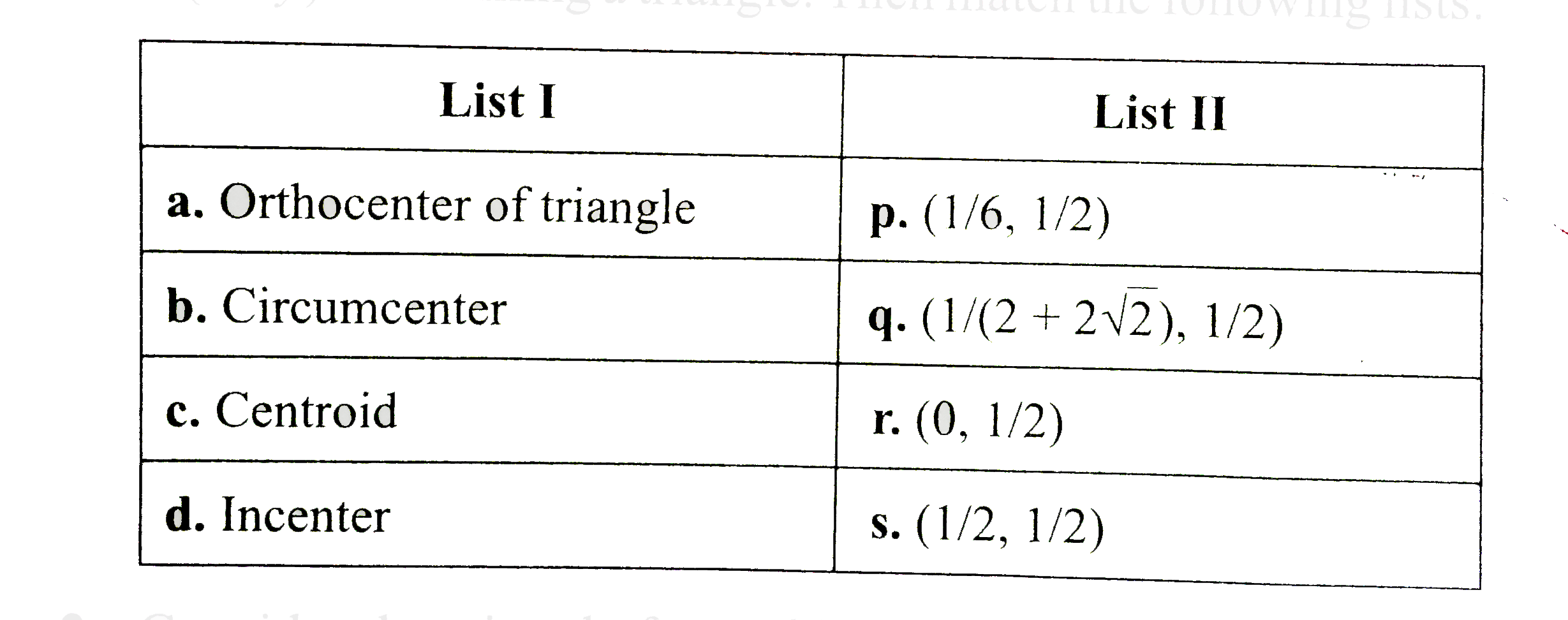If ABC having vertices A(acosθ1,asinθ1),B(acosθ2asinθ2),andC(acosθ3,asinθ3) is equilateral, then prove that cosθ1+cosθ2+cosθ3=sinθ1+sinθ2+sinθ3=0.Solution in Bengali
cosθ1+cosθ2+cosθ3=0
sinθ1+sinθ2+sinθ3=0
tanθ1+tanθ2+tanθ3=0
cotθ1+cotθ2+cotθ3=0
The correct Answer is:A, B
Vertices (acosθ1,asinθ1),(acosθ2,asinθ2), and origin is the circumcenter (centroid) of circumcircle. Therefore, the coordinates of the centroid are
(a(cosθ1+cosθ2+cosθ3)3,a(sinθ1,+sinθ2+sinθ3)3)
But as the centroid is the origin (0,0) we have cosθ1+cosθ2+cosθ3=0
and sinθ1+sinθ2+sinθ3=0
Topper's Solved these Questions
- BOOK - CENGAGE PUBLICATIONCHAPTER - COORDINATE SYSYEM EXERCISE - Linked10videos
COORDINATE SYSYEM
- BOOK - CENGAGE PUBLICATIONCHAPTER - COORDINATE SYSYEM EXERCISE - Matrix match type4videos
COORDINATE SYSYEM
- BOOK - CENGAGE PUBLICATIONCHAPTER - COORDINATE SYSYEM EXERCISE - Exercises59videos
COORDINATE SYSYEM
- BOOK - CENGAGE PUBLICATIONCHAPTER - COORDINATE SYSTEMEXERCISE - Multiple Correct Answers Type2videos
COORDINATE SYSTEM
- BOOK - CENGAGE PUBLICATIONCHAPTER - CROSS PRODUCTS EXERCISE - DPP 2.213videos
CROSS PRODUCTS
Similar Questions
For points P=(x1,y1)and Q=(x2,y2) of the co-ordinate plane a new distance d(P,Q)=|x1−x2|+|y1−y2| is defined .Let O(0,0)and A(3,2). The set of points in first quadrant which are equidistant from O and A is
06:01View SolutionConsider the lines represented by equation (x2+xy−x)×(x−y)=0 forming a triangle. Then match the following lists:
 10:40View Solution
10:40View SolutionABC is an isosceles triangle. If the coordinates of the base are B(1,3) and C(−2,7) , the coordinates of vertex A
02:22View SolutionCoordinates of points on curve 5x2−6xy+5y2−4=0 which are nearest to origin are
02:07View SolutionLet →a and →b be two vectors of equal magnitude 5 units. Let →p,→q be vectors such that →p=→a−→b and →q=→a+→b. If |→p×→q|=2{λ−(→a.→b)2}12, then value of λ is
01:34View SolutionIf DeltaABC having vertices A (acostheta_1, asintheta_1), B (acostheta_2, asintheta_2), and C (acostheta_3, asintheta_3) are equilateral triangle, then prove that cos theta_1 + costheta_2 + cos theta_3 = 0 and sintheta_1 + sintheta33
03:02View Solutionif theta_1, theta_2, theta_3, ........, theta_n are in AP then (sintheta_1 + sintheta_2 + ....... + sintheta_n) / (costheta_1 + costheta_2 + costheta_3 + ...... + costheta_n ) =?
12:58View SolutionIf (acosθ1,asinθ1),(acosθ2,asinθ2), and (acosθ3asinθ3) represent the vertces of an equilateral triangle inscribed in a circle. Then.
02:55View SolutionIf sinθ1+sinθ2+sinθ3=3, then cosθ1+cosθ2+cosθ3 is equal to
02:18View SolutionIf sinθ1+sinθ2+sinθ3=3, evaluate : cosθ1+cosθ2+cosθ3.
02:54View SolutionIf sinθ1+sinθ2+sinθ3=3, then cosθ1+cosθ2+cosθ3 is equal to 3 (b) 2 (c) 1 (d) 0
02:24View SolutionIf ABC having vertices A(acosθ1,asinθ1),B(acosθ2asinθ2),andC(acosθ3,asinθ3) is equilateral, then prove that cosθ1+cosθ2+cosθ3=sinθ1+sinθ2+sinθ3=0.
02:01View SolutionIf (acosθ1,asinθ1),(acosθ2,asinθ2) and (acosθ3,asinθ3) represent the vertices of an equilateral triangle inscribed in a circle, then (a) cosθ1+cosθ2+cosθ3=0 (b) sinθ1+sinθ2+sinθ3=0 (c) tanθ1+tanθ2+tanθ3=0 (d) cotθ1+cotθ2+cotθ3=0
01:37View SolutionIf ΔABC having vertices A(acosθ1,asinθ1),B(acosθ2,asinθ2),andC(acosθ3,asinθ3) are equilateral triangle, then prove that cosθ1+cosθ2+cosθ3=0andsinθ1+sinθ2+sinθ3=0
02:27View SolutionIf (acosθ1,asinθ1),(acosθ2,asinθ2), and (acosθ3asinθ3) represent the vertces of an equilateral triangle inscribed in a circle. Then.
06:00View SolutionIf sinθ1+sinθ2+sinθ3=3, then cosθ1+cosθ2+cosθ3 is equal to
06:01View Solution

